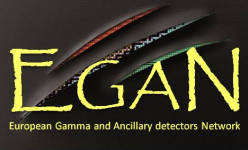Speaker
Francesco Recchia
(University of Padova)
Description
The future progress of gamma-ray spectroscopy studies relies on the capabilities of powerful devices based on the novel techniques of pulse shape analysis and gamma-ray tracking. The foreseen enhancement in performance compared to the present generation arrays depends on the capability to determine the amount of energy deposited in each interaction point of the photons and the position as well. This information is used to measure the energy of the photons through the reconstruction of their scattering sequence. This requires the digitization of the signals of each electrode of hundreds of segmented HPGe detectors and the use of powerful algorithms for the online data analysis. Such a technological effort was carried out in the last decade by two major collaborations, namely AGATA and GRETA.
Extensive Monte Carlo simulations suggest that the performance of such instruments will strongly depend on the accuracy in localizing the interactions. The installation of the first phase of AGATA, namely the AGATA Demonstrator, is ongoing in LNL. The commissioning experiments focus on the estimation of the position resolution through a measurement of the Doppler correction capability the first detector.
The first results obtained will be presented together with the procedure used to analyze the data. The value estimated for the position resolution is in good agreement with the basic design assumptions of AGATA. This confirms the feasibility of a gamma-ray tracking array, which will certainly have a large impact on a wide variety of physics.
Primary author
Francesco Recchia
(University of Padova)

